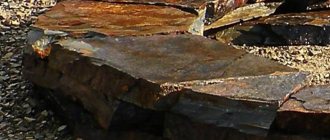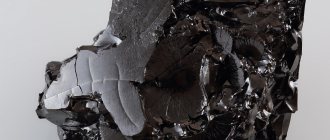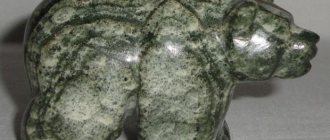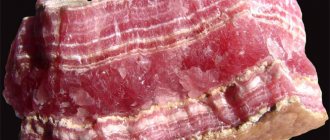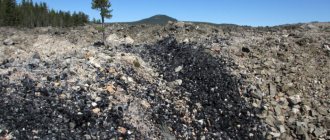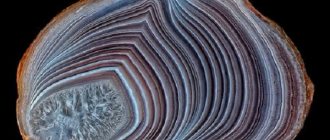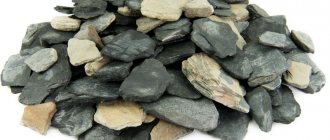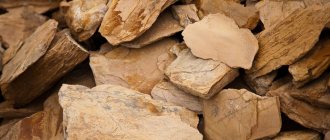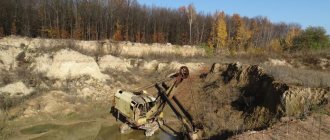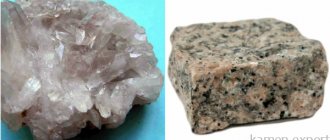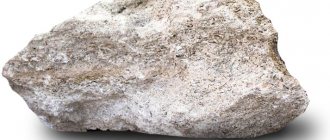Slate acquired its name because of its layered structure. The mineral is formed from compressed plates of various organic rocks. Clay stone flakes easily and can be cut with a knife. Shale formation occurs in the water column. Under the pressure of sea waters, it is formed from layers of silt and clay.
What are slates
So, before we talk about clay shales, we must say what kind of rock it is. In fact, shales are different types of rocks with a layered arrangement of mineral intergrowths. Its extraction requires quite a lot of effort, but despite this, it occurs in many parts of our planet.
The extraction of this material will be discussed in more detail a little later. In the meantime, it’s worth talking about the composition of this rather interesting stone.
Shale: mineral composition
The mineral composition of shale is quite varied. As the name suggests, stone is primarily composed of minerals. These include sericite, epidote, albite, quartz, etc. In a word, most rocks that belong to low-temperature or medium-temperature materials.
It’s worth mentioning one more point. Shales are divided into several groups according to their mineral composition. After all, they also contain other substances. It was they who became the reason for dividing shale into several types:
- Alum slate. This type of rock includes those whose composition includes carbonaceous matter and sulfur pyrites.
- Roofing slate.
- Slate slate.
- Hone. This type includes those clay shales that contain silica.
- And the last type is slate slate. It can be easily split into small columns.
That, in fact, is all that can be said about the mineral composition of this rock and its varieties.
Slate stone. Properties of slate. Description of slate
Slate is named so because of its ability to exfoliate, because of its structure. The rock is composed of compressed plates of various minerals. The layers separate quite easily. The origin of shale is connected with the seas. The silt and clay that settled on their bottom were compressed under water pressure.
Most shales are about 300 million years old. The rock was formed during an era of active volcanic processes in the earth's crust. Mountain building compressed sediments at the bottom in lateral planes. The resulting folds were stratified under pressure and temperatures.
Physical and chemical properties of shale
As a result of pressure on the bottom masses, layers of mica formed in the rock. This is a lamellar material, easily divided into thin sheets. This property was used in the old days by covering windows in houses with mica.
The mineral layers are transparent and thin. In shales, mica is also easily separated. In many ways, it is thanks to it that the rock easily breaks up into layers.
Layering is a general physical property of a stone. Otherwise, shales differ sharply from each other. Their hardness on the Mohs scale ranges from 2 to 6 points. For comparison, graphite used for pencil leads has a score of 2. 6 points for orthoclase, used in the production of porcelain and tiles.
The varying hardness of shales is explained by their different mineral composition and structure. The siliceous hard rock has a crystalline structure. Clay shales have a pronounced layered structure. They are more fragile.
The softest oil shale . It contains a high proportion of organic matter. These are rotting algae, mollusks, and other organisms. Their decomposition leads to the formation of flammable hydrocarbons. Actually, that’s why the rock is called combustible.
The moisture resistance of the breed also varies. Slate stone can absorb water as much as 3% or as little as 0.01%. The figure depends on the composition of the rock and its porosity. In fact, the concept of slate combines a whole group of finishing stones.
Shade and color of slate
Crystalline schists are usually dominated by dark-colored minerals. Of the whitish components, only feldspars and varieties of quartz are found in them. They give light veins, but in the overall mass the rock remains brown, gray, brown, black, dark green.
Shales come in white, reddish tones, and sometimes have a greenish or grayish tint. Often, slates are unevenly colored. This is caused by the different composition of rock layers, the time of their formation, and the mixing of stone elements under the influence of external factors such as pressure and temperature.
Application of slate
Slate is called “natural slate”. The stone received its nickname for its similarity to roofing coatings. The fractured layers of rock cover them for decades. Slate does not fade in the sun, so roofs always look like new.
In addition to resistance to ultraviolet radiation, most slates are frost-resistant, so the rock is used as a building material even in harsh climates.
For the construction of buildings they offer crystalline slate Blocks made from it retain heat well, have high sound insulation, are strong and durable.
Slate also used for exterior and interior decoration. Stone is used to cover fireplaces, decorate walls, columns, and pave floors. However, natural breed is expensive. A square meter costs from 1,800 rubles. The average price tag is about 3, 4 thousand.
Therefore, for example, artificial stone slate . It is made from pigments, resins, natural fillers and polymer materials. The latter are chemical compounds with an impressive molecular weight.
Externally, artificial stone is almost indistinguishable from natural stone. However, it lasts less. As for true slate, medieval castles and houses of nobles of past centuries are covered with it to this day.
At the same time, natural slate in most cases has not been changed since the construction of the buildings. Polymer slate is given a maximum guarantee of 50 years.
Magical and healing properties
Lithotherapists “prescribe” slate for insomnia and mental disorders. The stone has a positive effect on the nervous system, relieving stress and depression.
However, in the “urban jungle” all natural materials have such properties, skeptics note. In concrete boxes, in the absence of greenery, people lack wood, stone, flowers.
The decorative stone slate was noted not only in traditional medicine, but also in magical rituals. Esotericists advise lighting two candles on a full moon. This must be done at the border of the days at 12 o'clock at night. Slate is laid next to the fire .
Magicians say you should look at it for 20-30 minutes. As a result, the person performing the ritual should begin to see images. To interpret them you will need to turn to the stone. After the question, it is wrapped in a scarf and placed under the pillow. Deciphering visions comes in a dream.
The ritual is associated with the magical property of slate to accumulate the energy of the Cosmos and accumulate knowledge. The breed can transfer them to a person only after the ceremony. Wearing slate without performing appropriate magical rituals is useless.
Astrologers also comment on the properties of slate. They notice that the breed has a particularly positive effect on crayfish and fish. The secrets of the stone are revealed to them without difficulty, often the first time.
The knowledge gained helps uncollected representatives of the signs find their path in life and spend their time wisely. Shales have a negative effect on Aries and Capricorns. However, if they are poets, dancers, actors, an exception can be made. Slate favors creative people.
Application of the breed in question
This type of breed has been known since time immemorial. All over the world you can find buildings whose roofs are covered with roofing material made from it.
Where is shale used nowadays? The use of this fossil is quite large, but it is mainly used to create roofing, cladding and slate materials.
The stone is very popular for several reasons. First of all, because clay shales do not contain absolutely any harmful chemical impurities. And in our time, when almost every building material contains substances hazardous to our health, this method of finishing is simply worth its weight in gold. In addition, this stone is quite strong and reliable. The service life of such building material is more than a dozen years.
Quite often, bathrooms are finished with clay slate. This is due to the fact that the rock perfectly absorbs all moisture and this does not affect its service life in any way. What material can compare with this type of rock? Essentially none. The density of shale, its long service life and versatility make this material indispensable.
Qualities of slate as a building material
This breed has found wide application in the construction industry. Thanks to its matte shine and muted green color, the stone is also very popular in building decoration (both external and internal). It would not be amiss to list the most important qualities of building materials. Among them:
- Quite high strength.
- Resistance to mechanical deformation.
- Richness of shades.
- Resistant to high humidity and sudden temperature changes.
- Excellent sound insulation qualities.
- Low water absorption.
- Aesthetically attractive appearance.
Green slate is an excellent and versatile building material. It practically does not fade in the sun and retains its color for many years. Where exactly is it used? We will tell you about this further.
How is this rock mined?
Mining of the mineral is carried out in almost every corner of the Earth: Spain, Brazil, the United States of America. Russia also does not lag behind its competitors. Basically, rock mining is carried out in Siberia, as well as in the Urals, Kostroma and Kirov regions.
Unfortunately, at the moment, clay shales mined in Russia are not very popular, as a result of which it is bought abroad. So what is the reason for this unpopularity of the material? There are two reasons:
- Underdevelopment of the roofing slate market in Russia. That is why mining this rock is far from profitable.
- Low quality.
The material is mined in open pits. The rock layer is chipped off and further split into smaller pieces. Bulldozers and excavators are mainly used for mining.
Origin of the rock
Metamorphism is the process of structural modification of solid matter under the influence of sufficiently high temperatures and pressure. In geology there is also such a thing as facies. This is a collection of certain metamorphic rocks with approximately the same conditions of their formation. There are several types of such facies. The greenschist facies forms at relatively low temperatures and moderate pressure.
So, the rock we are considering is formed under moderate pressure (about 6-8x108 Pa) and a temperature range from 330 to 460 degrees Celsius. Greenschists are formed in the thickness of the earth's crust due to the transformation of volcanics (in particular, tuffs and basalts). Therefore, their composition contains an increased content of carbon dioxide (CO2) and water (H2O).
Medicinal properties
The stone in question has miraculous healing properties. According to experts, shale has a positive effect on absolutely the entire human nervous system. Great for relieving stress. That is why quite often this magnificent stone can be found in the interior of bedrooms or living rooms.
Another way to use oil shale for medicinal purposes is to purify water. The rock under study perfectly filters water from impurities of chlorine and heavy metals.
In addition, the stone is used in application procedures.
Mystical features of the material
Now you can turn to the magical properties of this material. Mages are confident that with the help of this stone you can get rid of mental pain in the shortest possible time, which is associated, for example, with a break in a relationship with a loved one.
Also, a pebble can serve as an excellent amulet. Slate protects against negativity and other problems that people quite often face. This decoration is especially suitable for people who are closely associated with creativity. This stone promotes the development of talent in a person, helps to create new interesting and unusual things. You can buy it at absolutely any jewelry store. It is used in many decorations.
Astrologers claim that slate suits almost all zodiac signs. The only exceptions are Capricorn and Aries. The stone is strictly contraindicated for them.
Where is it used?
Slate is a beautiful facing stone. It is used for finishing and construction work, as a fire-resistant material. It is suitable for interior decoration and exterior cladding of the house.
Full and partial slate finishing is used. The latter allows you to use stone to highlight a small section of the wall, tiling the corners, tiling doorways and windows around the perimeter, the ground floor, and the porch. For exterior work, unpolished layers of slate are often used. A stone with a natural chip looks much more expressive. Curtain facades made of such stone are widely used.
Slate is used to decorate gazebos, fences, garden paths, pillars, columns, and bodies of water (streams, ponds, fountains). Layers of stone are used to create waterfall cascades. Since slate is a heat-resistant material, it is often used to decorate a fireplace, and in the garden - barbecue and barbecue areas.
